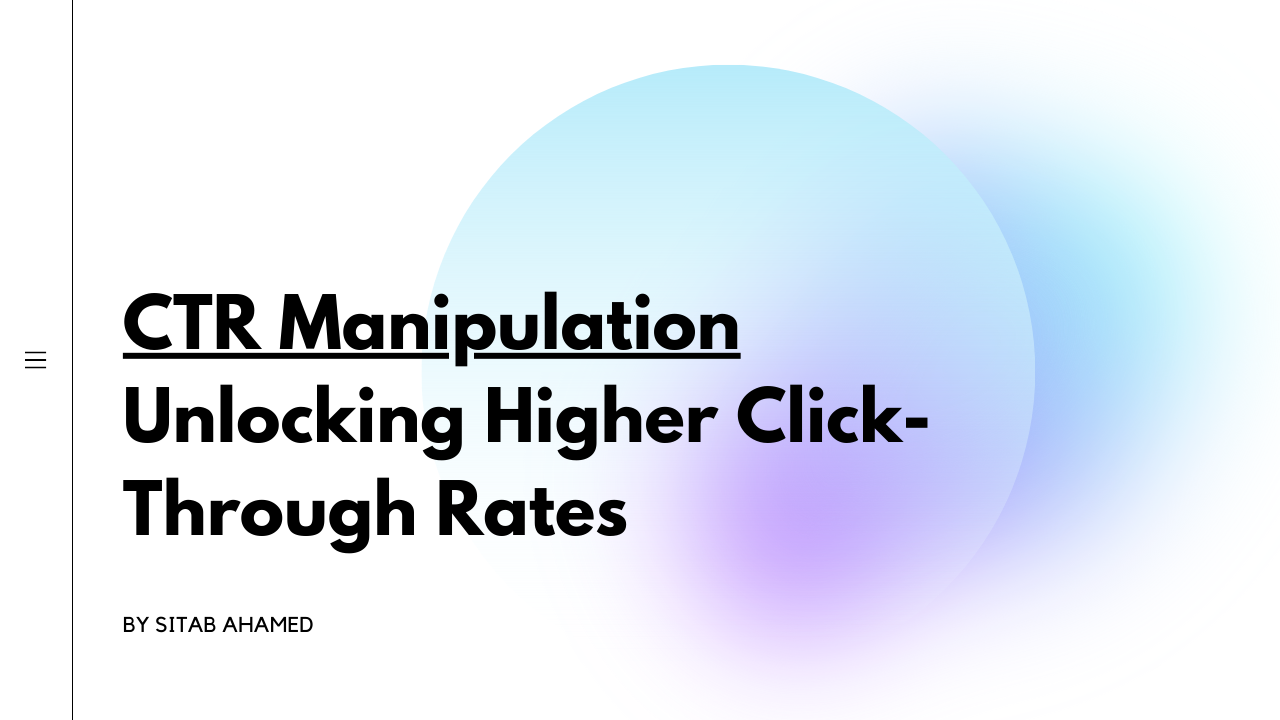CTR Manipulation: A Video Game Changer for Digital Campaigns
The increase of CTR control has actually unquestionably transformed digital marketing approaches, offering marketers with tools to enhance engagement and drive website traffic effectively. What implications might this stabilizing act hold for the future of electronic campaigns?
Understanding CTR Manipulation
Although click-through rate (CTR) manipulation might look like an uncomplicated technique in digital advertising and marketing, it includes an array of methods focused on synthetically blowing up engagement metrics. This control can take numerous forms, consisting of the use of click farms, robots, or deceptive advertisement placements that deceive consumers into clicking. These strategies can compromise the stability of performance data, making it testing for marketing professionals to gauge the authentic efficiency of their campaigns.
Moreover, CTR control increases moral worries, as it undermines the transparency of electronic marketing. The dependence on filled with air metrics can result in misdirected advertising choices, skewing source allotment and project approaches. Consequently, businesses might invest heavily in networks and techniques that appear successful but do not yield actual interaction or conversions.

Benefits of Click-Through Price Optimization
Enhancing click-through price (CTR) is necessary for improving the performance of electronic marketing projects. A higher CTR shows that a larger percentage of customers are engaging with the web content, which can result in raised web site web traffic and much better conversion rates. By enhancing CTR, brand names can efficiently allocate their advertising sources to efforts that produce the greatest returns.
Among the primary advantages of CTR optimization is the potential for boosted ad positioning and reduced costs - CTR Manipulation. Systems like Google Ads compensate greater CTRs with better ad positioning and lowered cost-per-click (CPC), enabling marketers to stretch their spending plans better. Furthermore, a well-optimized CTR can boost brand name visibility, as greater involvement rates commonly associate with enhanced natural reach

Strategies for Effective CTR Control
To properly manipulate click-through prices (CTR), marketing professionals can use a variety of calculated strategies that boost user interaction and drive website traffic. One fundamental technique is optimizing ad copy to develop engaging and action-oriented language. CTR Manipulation. Utilizing strong call-to-action (CTA) phrases motivates customers to take immediate action, boosting the chance of clicks
Another effective technique is A/B testing, which permits marketing experts to compare different ad variations. By systematically assessing efficiency metrics, they can determine which elements reverberate ideal with the target audience, thus fine-tuning their approaches for maximum effect. Furthermore, leveraging aesthetically enticing graphics and succinct messaging can record focus promptly, making it much more potential that customers will certainly involve.

Lastly, maximizing touchdown pages to make certain a seamless individual experience can reduce bounce rates and motivate more communication, ultimately cultivating higher CTR. By integrating these techniques, marketers can effectively adjust CTR to attain their campaign published here goals.
Determining Success in Digital Campaigns
Measuring success in electronic projects requires a clear understanding of key efficiency signs (KPIs) that straighten with campaign goals. KPIs function as quantifiable metrics that help analyze the efficiency of various strategies utilized throughout the campaign. Usual KPIs include click-through rates (CTR), conversion rates, cost per procurement (CPA), and roi (ROI)
To efficiently measure success, it is crucial to develop particular, quantifiable goals initially of the campaign. For example, if the primary objective is sites to raise brand recognition, metrics such as impressions and involvement rates might be prioritized. On the other hand, projects concentrated on direct sales would profit from a more in-depth evaluation of conversion rates and profits generated.
Routine evaluation of these KPIs enables marketing experts to make data-driven decisions, enhancing their approaches in real-time. Utilizing logical devices can assist in tracking performance and determining fads, allowing for quick changes to enhance campaign end results. Ultimately, a detailed strategy to measuring success not only highlights areas for enhancement yet additionally reinforces the total effectiveness of electronic advertising initiatives, driving sustained development and interaction in the long term.
Future Patterns in Digital Advertising
Preparing for the future of digital advertising and marketing discloses a landscape shaped by quick technological developments and altering consumer habits. As fabricated knowledge and maker understanding proceed to evolve, online marketers will progressively take advantage of these innovations to customize campaigns at an unmatched scale. Predictive analytics will make it possible for brand names to expect client demands, optimizing ad placements and material distribution in actual time.
Furthermore, the increase why not look here of voice search and smart devices is transforming how consumers connect with electronic material. Marketers will certainly need to adjust their approaches to make certain exposure across multiple systems, including voice-activated assistants. This change demands a concentrate on conversational advertising, emphasizing involvement with dialogue instead of conventional advertising strategies.
In addition, personal privacy concerns are motivating adjustments in information collection methods. Transparency and moral data use will certainly become extremely important, driving brand names to promote trust and commitment among customers. The ongoing advancement of social networks platforms will certainly likewise influence advertising and marketing methods, with an enhanced focus on authenticity and user-generated web content.
Verdict
In recap, CTR control represents a significant innovation in electronic advertising strategies, using instant advantages with enhanced involvement metrics. The continuous evolution of electronic advertising will depend on this delicate interaction, shaping the future landscape of brand-consumer communications.